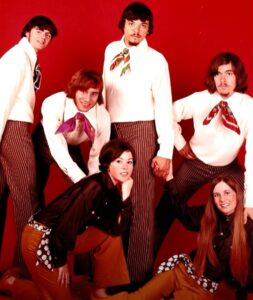Have Mercy: A Tampa Bay musical fable

It’s sweet, it’s sentimental, it’s even kind of sappy, but Jack Sigler Jr.’s song for his high school girlfriend was, in the summer of 1969, one of the biggest records in the country. “Love (Can Make You Happy)” made it all the way to No. 2 on the national charts, lodged behind the immovable Beatles and “Get Back.”
“Love (Can Make You Happy)” is a Tampa Bay record, all the way.
Sigler’s folk/pop band was called Mercy, assembled during his junior year at Brandon High. He wrote the song in 1966 for Ann Smith, who later became his wife. “Love (Can Make You Happy)” was Mercy’s only hit.

Jack Sigler. Facebook photo.
Jack Sigler, 74, currently resides in Inverness. He made a decent living from music for a long time, riding on the considerable coattails of his one-hit wonder. He has a gold record on the wall and a treasure trove of memories. His story is a dream come true and a cautionary tale.
His father was acquainted with a movie producer who was planning to shoot a low-budget, ultra-violent stock car drama, Fireball Jungle, in Tampa. If Mercy had a record, the big shot told Sigler Sr., he’d find a way to feature them performing it in his film.
WALT DJ and budding record producer Gil Cabot had an offer: For $300, he’d take you into H&H, one of Tampa’s two independent recording studios, and cut your song. The deal included 1,000 45 RPM records, plus marketing and promotion.
Sigler, 16 and eager, got Dad to pay up front, and signed away a percentage of his publishing to Cabot. The marketing and promotion never materialized.
Mercy appeared in an awkward “nightclub scene” in Fireball Jungle, which starred Lon Chaney Jr. in the waning days of his career. The movie was not a success.
(In this poor-quality clip – the only known footage of Mercy – Sigler is playing the red guitar; at far left is Ann Smith, the future ex-Mrs. Sigler):
But “Love (Can Make You Happy),” produced by Cabot and issued on a tiny label called Sundi, began to get airplay in several Florida markets in the fall of 1968. Sigler and his cousin, Ronnie Tuttle, drove across the state to deliver the single personally to disc jockeys.
 When it inexplicably began to take off nationally, Sigler, who had been drafted into the Navy, was at boot camp in Illinois. “I was laying in bed in my bunk, and this song came on,” he remembers. “I thought, that’s pretty. And then I realized it was “Love (Can Make You Happy),” and I jumped up screaming in the barracks, ‘That’s my song! That’s my song!’ That’s how I learned it was a hit.”
When it inexplicably began to take off nationally, Sigler, who had been drafted into the Navy, was at boot camp in Illinois. “I was laying in bed in my bunk, and this song came on,” he remembers. “I thought, that’s pretty. And then I realized it was “Love (Can Make You Happy),” and I jumped up screaming in the barracks, ‘That’s my song! That’s my song!’ That’s how I learned it was a hit.”
Shut up, said the other guys in the barracks. We’re trying to get some sleep.
It was at this point that the single raced up the charts. But who – what – was Mercy?
Cabot, who owned the record but not the name Mercy, quickly cashed in with an album called Love (Can Make You Happy), featuring the original Sundi single and a tepid collection of covers. The producer put together a trio consisting of his wife, his secretary and a random studio singer, and used a Tampa group called Mighty Manfred and the Wonder Dogs for the backing band.
The three women pictured on the album cover – credited to The Mercy, to get around the name problem – were models. They had nothing to do with the music inside.
Learning of this, Sigler was furious. He negotiated a deal with Miami producer Henry Stone, who would within a decade make some of history’s biggest disco records.
Stone agreed to produce an album by the “real” Mercy, and a deal was struck to release it through Warner Bros. Records.
Studio sessions were quick, as Sigler was home on leave and would have to report back for duty. The group re-recorded “Love (Can Make You Happy),” and, because of the time crunch, performed cover versions of recent hits by the likes of the 5th Dimension, the Association and Simon & Garfunkel.

Band photo for the back of the Warner Bros. album; Sigler, back in the Navy, missed the photo shoot. Image provided.
Sigler doesn’t even appear in the group photograph taken for the back cover; he had already left to return to the service.
Sigler sued Cabot and won; the “three models” album was quietly discontinued. It didn’t matter, however: Both the Sundi and Warner Bros. albums were flops.
A French label has issued both albums, together, on CD (it’s pictured below). And, Sigler reports, there’s a new compilation of 50 years’ worth of his music on the way from a British company.
“We’re getting out of Gil Cabot’s grasp, and we’re getting out of Henry Stone’s grasp,” he reports. “At the end of this year, all royalties belong to me. It took so many years.”
Cabot, meanwhile, was convicted of grand theft in Los Angeles in 1982, resulting in a prison stretch.
He spent another five years behind bars for extortion; he contacted a popular TV anchorwoman and said he was in possession of compromising photos of her. If she didn’t pay, he would publish them.
The photos didn’t exist; the woman worked with police to catch Cabot, who was tried and convicted.
“He’s the best con artist I have ever personally seen at work,” Deputy District Attorney Phil Rabichow told the Los Angeles Times.


